
How does YouTube Influence What We Eat?
Delicious smoothie bowls, miracle juices, and avocado toasts are all over the place and YouTube has contributed to this. Food channels on YouTube have changed the way we view the main supplier of our energy and what kind of it we consume, as well. How has this "broadcasting" platform managed to have an impact on our everyday food choices and to what extent?
Food reviews and information about what counts as ‘healthy’ used to be limited, and accessible only in newspapers or featured in food documentaries. However, everything changed since social media appeared, especially since YouTube was introduced. Everything is much more accessible, and this applies to food reviews and sources as well. Back in the day, being educated when it came to food was more difficult, and all food experts were highly respected people, while nowadays it seems like everyone possesses this title. All the information you need in order to know what food to consume and have a ‘healthy’ diet is gathered in one place – YouTube.
YouTube as a platform
YouTube is the biggest “platform for sharing self-made amateur videos, an 'alternative' to watching television” and was also the first video-sharing website (van Dijck, 2013). It functions as a platform for social networking, in which people can broadcast themselves. Therefore, it plays the role of a performative infrastructure (Gillespie, 2010). Moreover, YouTube “presented itself as a hybrid of broadcasting and of home video” (van Dijck, 2013). Even information scientists described the platform’s social function as a “small world phenomenon” (van Dijck, 2013).
However, it is a common misconception that YouTube is only a neutral intermediary and this is not really the case, because it not only facilitates our activities but also mediates our behavior (van Dijck, 2013). Social media works on the principle of ‘what interests you’ and promotes personalization. Much like other social media, it processes our (meta)data through algorithms in order to present us with the content that we want to see (van Dijck, 2013).
YouTube’s algorithms
People tend to believe that what they see online is based on their own freedom of choice. However, algorithms, protocols, and defaults shape their behavior and activities (van Dijck, 2013). YouTube’s algorithms provide the user with personalized videos based on five different sections: search, home, suggested videos, trending, and subscriptions. When a user clicks on a video, because his or her attention was caught by the headline or the picture, YouTube will respond by presenting more videos with similar content to the user.
"Platforms don't make the content; but they do make important choices about it” (Gillespie 2018)
Based on the desire to open the video clip, the user will be exposed to hundreds of videos in the same context, because this is what algorithms do. The platform sees this process as ‘helping’ users watch what they like and enjoy, but this is also the way in which YouTube keeps the viewers on the social network as long as possible. The way they are able to make this decision is by ‘following’ users’ engagements with each video they watch. More precisely, the algorithms “pay attention to which videos each user watches, what they don’t watch, how much time they spend watching each video, their likes and dislikes, and their “not interested in” feedback” (Chi, 2019).
However, it turns out that YouTube does not shape only the user’s behavior, but also has an effect on the video producers – what the video is going to be about, how long it is going to be, when it is going to be published, what keywords are going to be used – in order to gain as many views as possible. Although the social media platform connects the videomakers with viewers, they set up the rules – the technical standards, what counts as a commodity, and how long the content is kept (Gillespie, 2010).
Any producer who does not follow the regulations will be either removed from the platform, or the content which they produce will be suppressed in the sense that it will be less visible because according to YouTube, it does not have content value. Thus, algorithms are contributing to making some users more popular than others by giving their uploaded videos more visibility. Therefore, YouTube’s protocols undercut the impression that the platform treats all of its users equally. As Gillespie (2018) states: “For the most part, platforms don't make the content; but they do make important choices about it”.
Figure 1: YouTube search results for "what i eat in a day"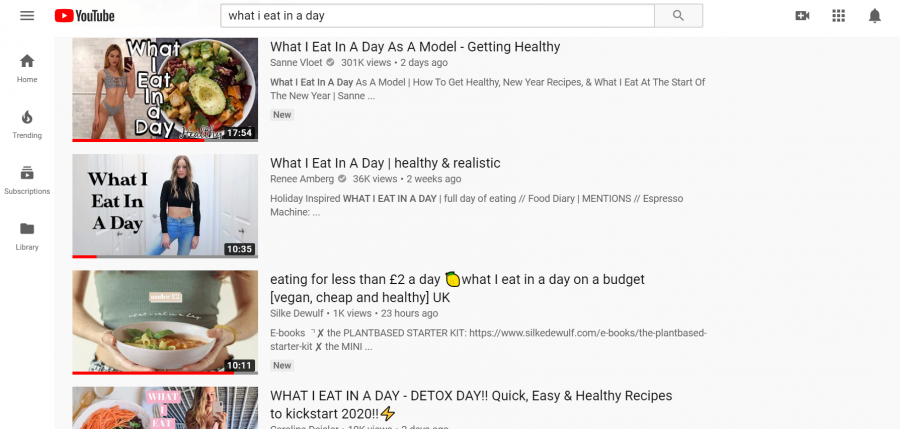
Are ‘What I eat/ate in a day’ videos the new trend?
The first ‘what I eat/ate in a day’ type of video was uploaded on YouTube in 2014 by Durian Rider who is a vegan vlogger trying to promote the vegan diet. However, he probably did not realize at that time that he set the beginning of a whole new food trend on YouTube.
Over the period of six years, the number of that kinds of videos grew dramatically, reaching the level where YouTubers and entire YouTube channels are constructing their online identity based on them. ‘What I eat/ate in a day’ videos are the informal version of the cooking shows on “24Kitchen” or “Food Network”, but presented in a more interactive and even personal way, because the creators allow the viewers to see a part of their intimate life. However, who are these people you might wonder? Well, some of them are ordinary people, who decided to start a YouTube channel in order to, as they claim, inspire people to try new meals and new food combinations. Some are celebrities or models who want to show their fans how and what they eat, and others are professional dieticians who are aiming to present the audience with what is healthy eating according to science. Although these are all ‘what I eat/ate in day’ videos, each of them is addressing a particular audience.
The range of these videos is super-diverse – vegan; non-vegan; high carb, low fat; high protein; for losing weight; for gaining weight; paleo; as a model; for a healthy lifestyle, etc. If you think that your diet is special, and no one eats like you, just go on YouTube and you will find that there is at least one person who eats the same way as you. But more surprising is the fact that most videos are even divided into periods – ‘what I eat/ate in day’ spring version, summer, autumn, and winter. Therefore, it is important for the producers to underline the fact that they have eaten a specific food item during winter, but not during the spring, for example.
These types of videos are not only popular, but they have also transformed into a real trend, which grows more and more every year, due to the fact that people enjoy watching what someone ate the previous day or one week ago. For example, Sadia Badiei, known as ‘Pick Up Limes’ on social media, has 2.14 million subscribers on YouTube based on sharing ‘What I eat/ate in a day' videos and recipes. Thus, 2.14 million people are waiting every week to see what she had done and eaten during the week, which is evidence that millions of people are constantly engaging with that kind of content. However, Sadia is not the only one: there are hundreds of YouTube channels creating the same type of videos with hundreds and thousands of subscribers.
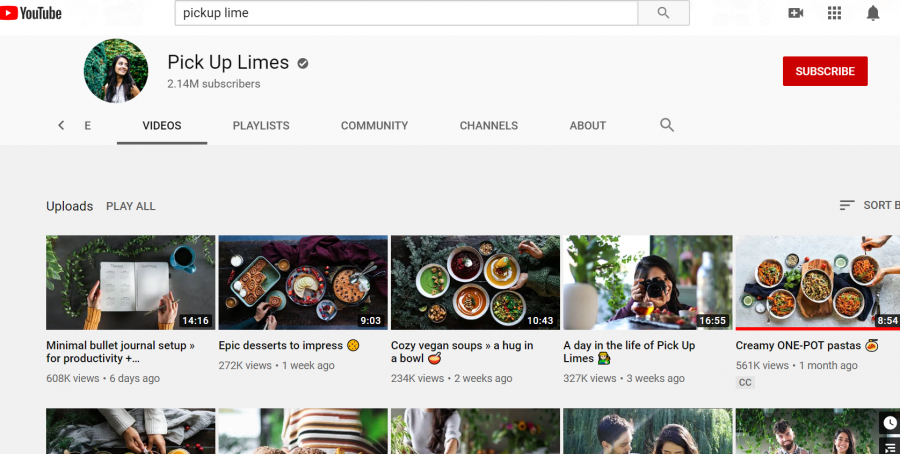
Figure 2: Pick Up Limes' YouTube channel
Does social media have an impact on our food choices?
Social media is a huge part of our everyday life, in which we spend hours scrolling down our feeds and watching our friends’ profiles in order to ‘not miss anything’. It is even fair to state that we live most of our lives online on a constant watch for what is the new popular thing.
The question is to what degree our feed feeds us
From my own observation, based on my six years of active participation on social media, I can state that topics related to food and health are a constant part of the top ten trendy discussions on the web. We encounter the era of healthy eating, in which people are obsessed with ‘healthy’ foods, which must have been approved of as such on at least one social media platform. Therefore, the question is to what degree our feed feeds us.
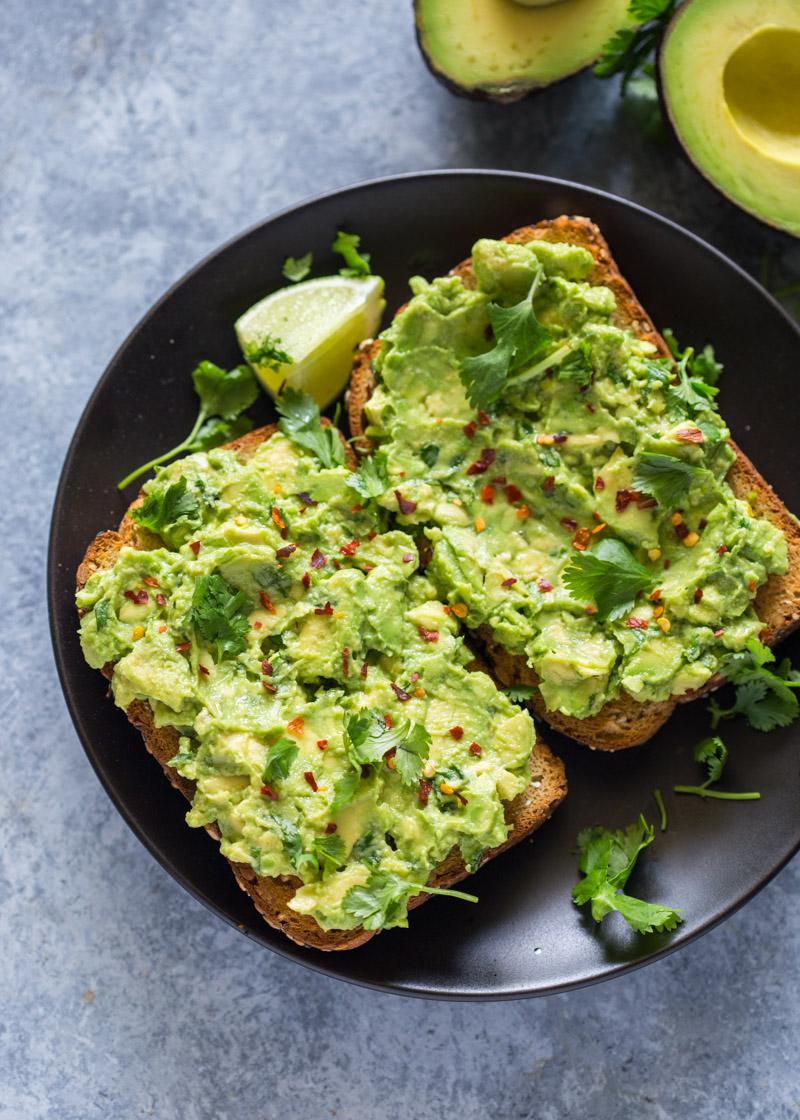
Figure 3: Avocado Toast
The avocado toast trend, which started in 2010 and now has its own Wikipedia page, is one of the first examples of social media playing the role of a guide towards ‘healthy’ meals for users. Our feeds were overtaken by pictures and stories of avocados and the hashtag #avocado was everywhere on Instagram, Facebook, Twitter, and YouTube. This viral trend went to the point where if you are not having avocado toast for breakfast or snack, you cannot consider yourself ‘healthy’ at all.
Another food trend, owing its existence to social media in 2019, was the famous celery juice, which was the first thing to drink when you wake up instead of water or coffee. The tag #celeryjuice was used thousands of times by #instafamous girls, posing with their juices every morning like in the post of the TV producer and fashion journalist @dialamakki.
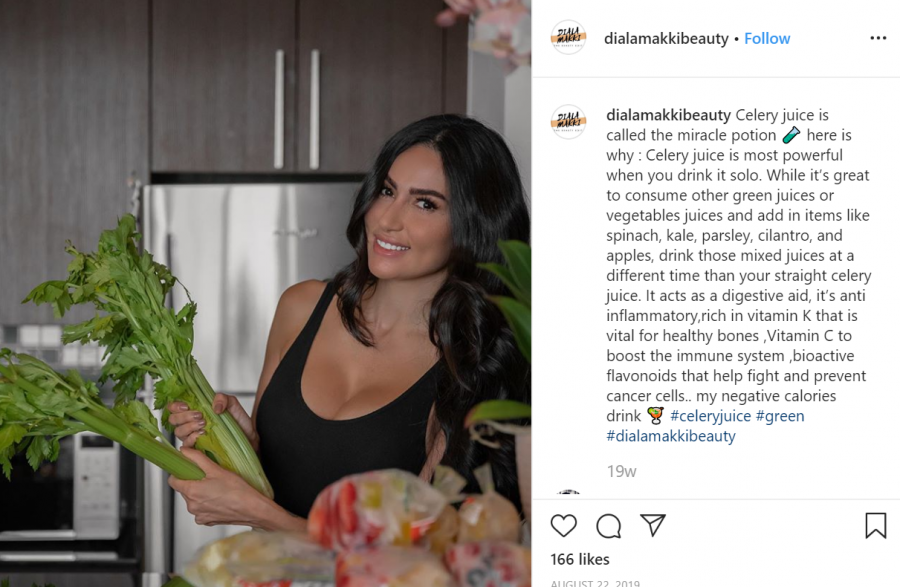
Figure 4: An ode to the famous celery juice by @dialamakkibeauty
Just like Diala, many celebrities like the fashion model Rosie Huntington-Whiteley and the actress Jenna Dewan were promoting this ‘miracle green potion’ that was promising all drinkers detox, flawless skin, and overall wellness, even though the health benefits of the celery juice are still rather questionable. Even Jenna Dewan stated in an interview for ‘Us Weekly’: “My one biggest tip I tell everyone is that years ago I stopped eating breakfast in the morning.” Instead, she makes “a big green smoothie... That really transformed my body, my skin and just my energy level throughout the day.”
As I already mentioned above, social media facilitates and influences our behavior, activities, and habits online and offline, and as we observed from previous years, social media definitely has an effect on our food choices - from what we should drink in the morning to what should be our last meal for the day. However, just because something is claimed to be good for your body on social media, does not always mean that it is actually beneficial. Furthermore, only because some food is labeled as popular or trendy online you do not have to eat it in order to be ‘healthy’ because most of the food with a ‘healthy’ stamp has not survived the test of science in regards to its ‘magical powers’ towards our bodies.
What we see is the power of recommendation, because people take other people's words for granted for they are ordinary people just like them, and reading or hearing about the supposed effects of, for instance, celery juice, from people who are consuming it, makes them believe these juice promoters more than medical professionals and doctors.
Just because something is claimed to be good for your body on social media, does not always mean that it is actually beneficial
The influence of YouTube over what we eat
YouTube is the leading platform for videos which sets the trends based on what kinds of videos users count as interesting, but at the same time it puts frames for the producers over what content they should upload in order to be more visible, and therefore more popular. As we already discovered, ‘What I eat/ate in a day’ videos are a big trend on YouTube, and their number is growing every year. However, does this type of content serve only as some sort of entertainment for the users, or does it actually have an influence on what they consume?
In order to find out an answer to this question, I went through the comment section of different ‘What I eat in a day’ videos in order to see how viewers react to these videos. Many of the users share their love and interest for them by posting comments like: “Yes more videos like these!” and “Loved loved loved the video...”. Besides these comments, many others, which were posted under the videos were about the viewers finding the meals and recipes in the particular video very inspiring and cannot wait to try them (Figure 1). One YouTube user stated: “Loved this! I definitely have to get the Nutri Bullet and make the smoothies a daily part of my routine!”.
Even though these comments are illustrating the power of these videos over people, they do not prove that people necessarily eat these foods or follow these diets. It is not a secret that in the world of influencers, they get paid for almost everything they do - posting pictures and stories, showing specific products, or mentioning a brand - but influencers themselves pay for followers, likes, and comments. Therefore, there is never a guarantee that these comments are true or just another strategy of YouTube influencers to popularize their videos. Figure 4: Users comments under ‘What I eat in a day’ videos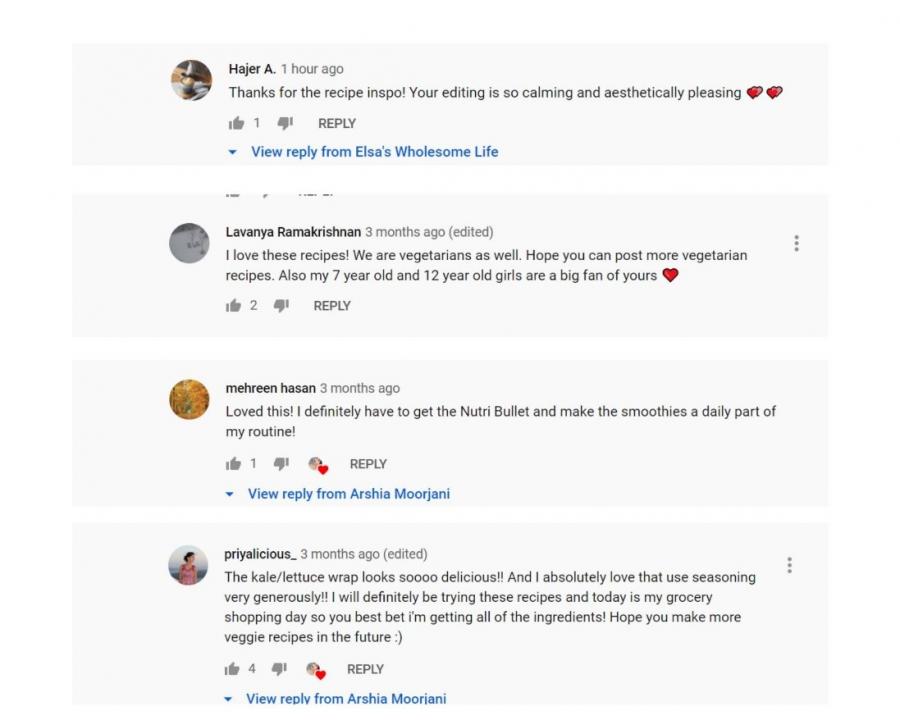
Another way in which YouTube has an impact on what we eat is by giving an online space for YouTube channels like ‘Village Food Channel’, ‘Food Network’, and ‘Tasty’ to not only exist but also grow and turn into our online cookbooks. All of these channels are dedicated to sharing appetizing and delicious recipes, and they have millions of subscribers.
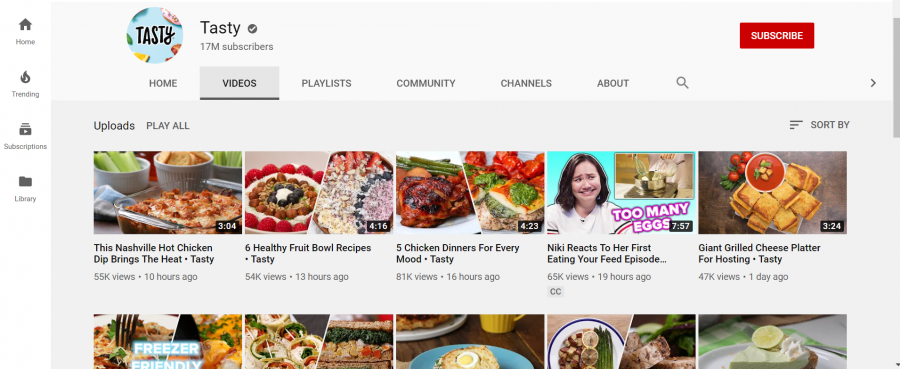
Figure 3: Tasty's YouTube channel
‘Tasty’ is the most popular food channel on YouTube with over 17 million subscribers and with each video has tens of thousands of views. This ‘online cooking show’ provides its viewers with a diverse range of good-looking and ‘healthy’ meals from all over the world.
Therefore, YouTube influences our food choices constantly by making food videos more and more trendy and visible to users because of the platform’s algorithms. However, the positive side of this is that you do not need to spend a ridiculous amount of money for a dietitian to tell you what to eat every day in order to lose weight, build muscle, or simply eat ‘healthy’, and you do not have to spend money on cookbooks to add new recipes to your diet, or pay extra for additional TV-channels, so that you could watch all cooking shows, because YouTube is here for you, to provide you with all of that and even more.
The food on our feed
Food is crucial for every human being and due to the changes in its quality and all kinds of health problems that we are facing nowadays, it is not surprising at all that food is a very much discussed topic online. As I mentioned above, we are living in a time in which people become more and more concerned about what they put in their bodies in order to get all the nutrients they need. Nutrition information is easily accessible by just opening YouTube, where we are exposed to the “perfect examples of healthy eating and endless smoothie bows” (Sportstec Clinic, 2018).
The influence which YouTube as a platform has over what we eat is undoubtedly big – from the perfect breakfast to the healthiest dinner. Even some of the meals I eat every day are taken from ‘What I eat in a day’ videos in order to provide my body with more diverse food that is supposed to give me all the necessary minerals and vitamins without making compromises in regards to taste. It is rather interesting why we are so attracted to watching what other people consume every day, but we know for sure that it is not just to kill the time, we can actually benefit from this a lot.
However, YouTube can confuse our expectations about what healthy eating looks like. We are confronted with pictures of delicious-looking food standing next to perfect-looking bodies, but it is important to remember that health comes in different shapes and sizes, and food does not have to be a beautiful work of art, it only needs to work out for you and your body. Moreover, just because some particular food is good for someone, it does not mean that it will be good for everyone. We all work differently, and thus YouTube should not be our only source when it comes to our health.
References
Chi, Cl. (2019). YouTube Algorithm: The Constantly Updated Guide to YouTube’s Updates & Changes. Hubspot Blog.
Cooper, P. (2019) How Does the YouTube Algorithm Work? A Guide to Getting More Views. Hootsuite.
Does social media influence what you eat? (n.d.). Sportstec Clinic.
durianrider. (n.d.). YouTube.
Gillespie, T. (2018) Custodians of the Internet. Yale University Press
Jones, A. (2019) Celery Juice Is the Perfect, Probably Pointless Trend for 2019. Vanity Fair.
Meola, K. (2019). Stars on the Celery Juice Wellness Trend Love Train: Pharrell Williams, Jenna Dewan and More. US Weekly
Pick Up Limes. (n.d.). YouTube.
Tasty. (n.d.). YouTube.
van Dijck, J. (2013) The Culture of Connectivity. Oxford University Press.